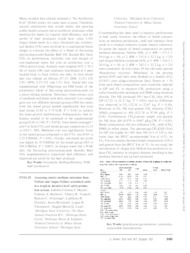Assessing enteric methane emissions from Nellore and Angus-Nellore crossbred cattle in a tropical, intensive beef cattle production system.
Assessing enteric methane emissions from Nellore and Angus-Nellore crossbred cattle in a tropical, intensive beef cattle production system.
Author(s): MACIEL, I. C. F.; BARBOSA, F. A.; TOMICH, T. R.; ALVARENGA, R. C.; FERREIRA, L. R.; ROWNTREE, J.; THOMPSON, L. R.; LANA, A. M. Q.
Summary: Crossbreeding has been used to improve performance in beef cattle; however, the effects of breed composition on methane production, yield and intensity from cattle in a tropical intensive system remain unknown. To assess the impact of breed composition on enteric methane emissions, Nellore (NE; yr 1: BW = 171.5 ± 19.4 kg; n = 10; yr 2: BW = 215.8 ± 32.3 kg, n = 25) and Angus-Nellore crossbred (AN; yr 1: BW = 214.2 ± 26.4 kg, n = 10; yr 2: BW = 242.5 ± 32.2 kg, n = 25) were compared. At trial onset, 10 mo old steers grazed Megathyrsus maximus ?Mombaça? in the grazing period (GP) and then were finished in a feedlot (FL) (35:65% corn silage:concentrate diet). Steers (n = 8) from each breed composition were randomly selected in GP and FL to measure CH4 production using a sulfur hexafluoride technique and DMI using titanium dioxide. The NE produced 19% less CH4 than AN in GP (17.21 vs 21.17 kg, P < 0.01), and no difference was observed in FL (22.34 vs 22.67 kg, P > 0.10). However, in FL, NE had greater CH4 intensity (CH4/ADG) compared to AN (122.76 vs 97.49 g/kg, P < 0.01). Furthermore, CH4/carcass weight was greater for NE than AN (0.079 vs 0.067 g/kg CW, P < 0.01). Breed composition did not influence CH4 yield (CH4/DMI) in either phase. The percentage CH4/GEI (Ym) for GP was higher for AN than NE (4.5 vs 3.8%), but lower than the IPCC recommended Ym of 6.5%. In FL, Ym was similar between breed composition (5.0%) and greater than the IPCC Ym of 3%. In our study the introduction of Angus into Nellore has potential to reduce CH4 intensity in tropical climates, resulting in less methane emission per kg beef produced.
Publication year: 2019
Types of publication: Abstract in annals or event proceedings
Unit: Embrapa Maize & Sorghum
Observation
Some of Embrapa's publications are published as ePub files. To read them, use or download one of the following free software options to your computer or mobile device. Android: Google Play Books; IOS: iBooks; Windows and Linux: Calibre.
Access other publications
Access the Agricultural Research Database (BDPA) to consult Embrapa's full library collection and records.
Visit Embrapa Bookstore to purchase books and other publications sold by Embrapa.

